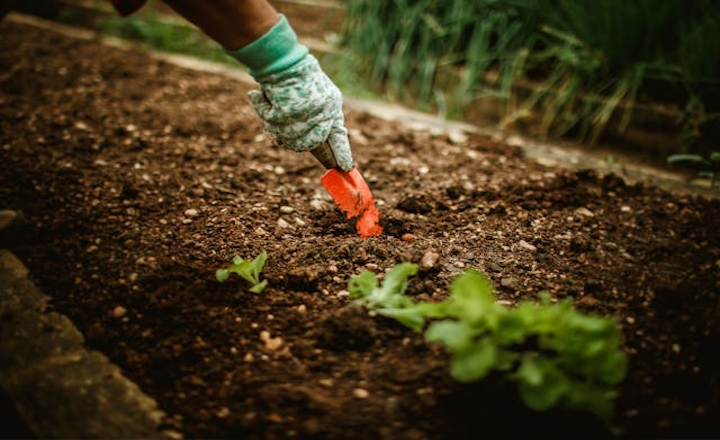
Gardening in the summer heat can be a challenge, but with a few key strategies, you can keep your plants happy and healthy. The most important thing to remember is that high temperatures increase the rate of water evaporation from both the soil and the plant leaves, making proper watering and moisture retention crucial.
Watering Wisely
To keep your plants healthy in the summer, water them deeply but not too often. This helps their roots grow deeper, making them stronger against hot, dry weather.
The best time to water is in the early morning. This lets the water soak into the soil before the sun evaporates it. Watering at night can also work, but it can sometimes cause leaf diseases.
Avoid watering in the middle of the day, as most of the water will simply evaporate.
To see if your plants are thirsty, stick your finger about two inches into the soil. If it feels dry, it's time to water. Keep in mind that potted plants need water more often, sometimes even daily, when it's very hot.
A common mistake is not watering enough. A light sprinkle on the surface won't reach the roots. Instead, water slowly and deeply until the soil is soaked. For a garden bed, you might let a soaker hose run for an hour. For a single plant, a slow, steady stream for a minute or two is usually enough. You'll know you've watered enough when you see water start to pool on the soil's surface.
Mulch and Moisture Retention
Protect your plants from the summer sun by mulching them. A two to three-inch layer of mulch on top of the soil acts like a blanket, keeping the ground cool and moist. This also helps stop weeds from growing, which compete with your plants for water.
You can use mulches like wood chips, shredded bark, or straw. As they break down, they make the soil healthier. Just be sure to keep the mulch a few inches away from the plant's stem to prevent rot.
For vegetable gardens, straw or grass clippings are good and inexpensive choices. For flower beds, decorative shredded bark looks nice while still protecting your plants.
Mulch is more than just a moisture saver; it also keeps the soil temperature stable. This is especially important for plants with shallow roots and new seedlings that are easily hurt by heat.
Pruning and Deadheading
Pruning in the summer is all about keeping your plants healthy. Remove any dead, diseased, or damaged branches so the plant can focus its energy on new growth. Use sharp tools like loopers to make clean cuts.
An important summer task is deadheading, which means removing old, faded flowers. For many plants, this encourages them to produce new flowers, extending the blooming season. To deadhead, simply snip or pinch off the faded flower just below its head or at the first healthy leaves.
Don't do a heavy pruning in the summer, as this can stress a plant that is already dealing with heat. Stick to light pruning and deadheading to keep things neat and encourage new growth.
For shrubs and trees, you should only remove a few problem branches, like ones that are damaged or blocking light from the rest of the plant. When you cut, make sure to make a clean cut right outside the branch collar, the swollen area where the branch meets the main stem. This helps the plant heal faster. The goal of summer pruning is to improve the plant’s health and airflow, not to change its shape entirely.
Fertilising and Feeding
In the summer, it's best to fertilise less or not at all. The heat already stresses plants, and a strong fertiliser, especially one high in nitrogen, can cause a sudden growth spurt that requires a lot of water and can burn the roots.
If you must fertilise, use a slow-release granular fertiliser or a liquid fertiliser at half strength. Organic options like compost tea or fish emulsion are also good because they are gentler. Plants in containers often need a light feeding every few weeks since they lose nutrients faster.
The main reason to hold off on fertiliser is that plants slow down in extreme heat. They're focused on surviving, not on growing. Adding fertiliser forces them to grow new leaves and stems, which demands more water than the plant may have. This can make the plant's condition worse.
Pests and Diseases
The summer heat often brings pests and diseases to the garden. Look out for common issues like spider mites, aphids, and powdery mildew. Spider mites love hot, dry weather; you can often get rid of them with a strong spray of water. Powdery mildew, a white fungus, appears in humid conditions and can be managed by giving your plants more space for air to circulate. Checking your plants often will help you catch these problems early.
The best way to prevent pests and diseases is to keep your plants healthy. Stressed plants are more likely to have problems. By watering correctly, mulching, and not over-fertilising, you give your plants the best chance to protect themselves. If you do find a problem, try to identify what it is before you treat it. Many natural solutions are available that can be effective without hurting helpful bugs like bees and ladybugs, which are good for your garden.
Providing Shade
When plants are getting too much sun, giving them some shade can help a lot. You can create temporary shade with a shade cloth, an old sheet, or a patio umbrella. This is especially useful for vegetables like lettuce that don't like intense heat. For new plants, a simple cardboard box or a piece of wood can give them protection during their first week.
You can also use taller plants to shade shorter ones. For example, planting tall sunflowers or corn on the south side of a row of vegetables can give them a natural shield from the afternoon sun. This is a great way to design your garden while also protecting your plants from the heat.
Keeping Your Lawn Healthy
Your lawn needs some special attention to stay green in the summer. Raise your lawnmower blade so the grass is at least three inches long. Taller grass shades the soil, keeping it cooler and helping it hold onto moisture. It also helps the roots grow deeper, making your lawn more resistant to drought.
Just like with your plants, water your lawn deeply but not too often. Your lawn needs about one inch of water per week from either rain or your sprinklers.
It's best to avoid fertilising your lawn during a heatwave. This can stress and burn the grass. Wait until the cooler fall temperatures to fertilise. When you mow, consider leaving the grass clippings on the lawn. This is called "grasscycling," and it puts nutrients back into the soil while also acting as a natural mulch to help keep moisture in.
By following these tips, you can ensure your garden not only survives the summer but thrives in it. Paying attention to your plants' needs and providing them with the right care will make all the difference. Happy gardening!




